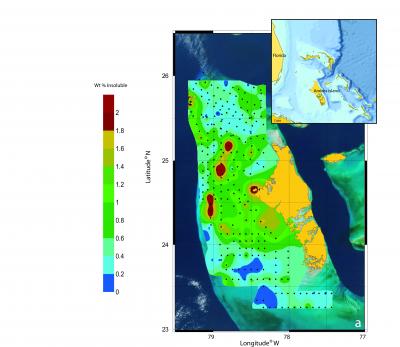New research suggests Saharan dust is key to the formation of Bahamas' Great Bank

Distribution of insoluble material in the sediments and collection sites are shown. The insoluble material is derived from atmospheric dust. Credit: Peter Swart, Ph.D., UM Rosenstiel School of Marine and Atmospheric Science
A new study suggests that Saharan dust played a major role in the formation of the Bahamas islands. Researchers from the University of Miami (UM) Rosenstiel School of Marine and Atmospheric Science showed that iron-rich Saharan dust provides the nutrients necessary for specialized bacteria to produce the island chain's carbonate-based foundation.
UM Rosenstiel School Lewis G. Weeks Professor Peter Swart and colleagues analyzed the concentrations of two trace elements characteristic of atmospheric dust – iron and manganese – in 270 seafloor samples collected along the Great Bahama Bank over a three-year period. The team found that the highest concentrations of these trace elements occurred to the west of Andros Island, an area which has the largest concentration of whitings, white sediment-laden bodies of water produced by photosynthetic cyanobacteria.
“Cyanobacteria need 10 times more iron than other photosynthesizers because they fix atmospheric nitrogen,” said Swart, lead author of the study. “This process draws down the carbon dioxide and induces the precipitation of calcium carbonate, thus causing the whiting. The signature of atmospheric nitrogen, its isotopic ratio is left in the sediments.”
Swart's team suggests that high concentrations of iron-rich dust blown across the Atlantic Ocean from the Sahara is responsible for the existence of the Great Bahama Bank, which has been built up over the last 100 million years from sedimentation of calcium carbonate. The dust particles blown into the Bahamas' waters and directly onto the islands provide the nutrients necessary to fuel cyanobacteria blooms, which in turn, produce carbonate whitings in the surrounding waters.
Persistent winds across Africa's 3.5-million square mile Sahara Desert lifts mineral-rich sand into the atmosphere where it travels the nearly 5,000-mile northwest journey towards the U.S. and Caribbean. The paper, titled “The fertilization of the Bahamas by Saharan dust: A trigger for carbonate precipitation?” was published in the early online edition of the journal Geology. The paper's authors include Swart, Amanda Oehlert, Greta Mackenzie, Gregor Eberli from the UM Rosenstiel School's Department of Marine Geosciences and John Reijmer of VU University Amsterdam in the Netherlands.
About the University of Miami's Rosenstiel School
The University of Miami is one of the largest private research institutions in the southeastern United States. The University's mission is to provide quality education, attract and retain outstanding students, support the faculty and their research, and build an endowment for University initiatives. Founded in the 1940's, the Rosenstiel School of Marine & Atmospheric Science has grown into one of the world's premier marine and atmospheric research institutions. Offering dynamic interdisciplinary academics, the Rosenstiel School is dedicated to helping communities to better understand the planet, participating in the establishment of environmental policies, and aiding in the improvement of society and quality of life. For more information, visit: http://www.rsmas.miami.edu.
Media Contact
All latest news from the category: Earth Sciences
Earth Sciences (also referred to as Geosciences), which deals with basic issues surrounding our planet, plays a vital role in the area of energy and raw materials supply.
Earth Sciences comprises subjects such as geology, geography, geological informatics, paleontology, mineralogy, petrography, crystallography, geophysics, geodesy, glaciology, cartography, photogrammetry, meteorology and seismology, early-warning systems, earthquake research and polar research.
Newest articles

Superradiant atoms could push the boundaries of how precisely time can be measured
Superradiant atoms can help us measure time more precisely than ever. In a new study, researchers from the University of Copenhagen present a new method for measuring the time interval,…

Ion thermoelectric conversion devices for near room temperature
The electrode sheet of the thermoelectric device consists of ionic hydrogel, which is sandwiched between the electrodes to form, and the Prussian blue on the electrode undergoes a redox reaction…

Zap Energy achieves 37-million-degree temperatures in a compact device
New publication reports record electron temperatures for a small-scale, sheared-flow-stabilized Z-pinch fusion device. In the nine decades since humans first produced fusion reactions, only a few fusion technologies have demonstrated…





















